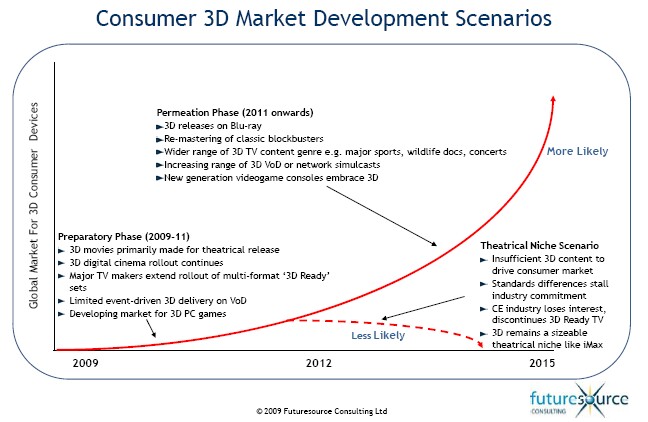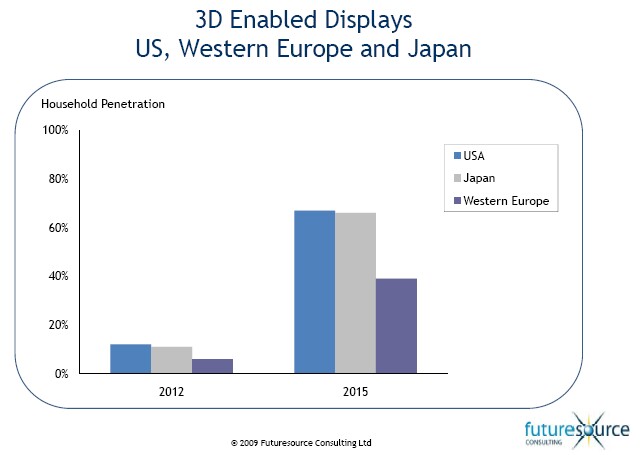More than 10% of US and Japanese households will be '3D enabled' by 2012
Friday, May 8th, 2009
Now more than ever 3D is coming to the fore, with backing from all major sectors of the entertainment and consumer electronics industries. 3D movie production is intensifying, cinemas all over the world are investing in 3D technologies and feedback from audiences has been highly positive, with encouraging ticket sales. Yet the ultimate goal is to bring 3D to the home, and Futuresource Consulting’s newly-released ‘Strategic Impact of 3D’ report reveals studios, consumer electronics companies, broadcasters, video game vendors and network operators are all poised to power 3D through the consumer diffusion curve.
“Consumers are starting to experience the new wave of 3D technologies at the cinema and through Digital Out of Home advertising, and it won’t be long before there’s a groundswell of demand for 3D within the home,” says Sarah Carroll, Director of Continuous Services, Futuresource Consulting. “With over 200 million new TVs sold across the globe every year, the potential is huge, but the industry needs to overcome some serious obstacles in order to kick start and fully realise the revenue streams.
“Most notably, technical and standards issues still need to be resolved and there is a limited supply of 3D content, with the current economic climate making new investment in production and distribution a challenge, particularly for the broadcast industry. That said, there is a real feeling of excitement surrounding 3D and here at Futuresource we believe this will translate into commercial success within the next three to five years.”
All eyes will be on the consumer electronics industry, with ‘3D Ready’ TVs a prerequisite to consumer adoption in much the same way as ‘HD-Ready’ sets were used to seed the high definition market five years ago. An early decision on the Blu-ray 3D standard will also be critical, as packaged media will be necessary to help drive the market.
“Custom chipsets can be embedded into next gen hardware at relatively low cost,” says Carroll. “Combine this with an integrated consumer awareness programme and a coherent ‘3D-Ready’ branding strategy, and the resulting price premium on hardware will more than offset the additional manufacturing costs.”
Hundreds of interviews with leading Hollywood studios, hardware vendors, cinema owners, broadcasters, content production companies, technology groups and service providers have amassed a wealth of expert opinion on the future of 3D, enabling Futuresource to piece together its 3D probability curve, outlining the most likely market development scenarios.

“Our analysis points to the emergence of two distinct phases as we move through the diffusion curve,” says Jim Bottoms, Managing Director of Corporate Development at Futuresource. “Currently, we’re easing into the preparatory phase, which will stretch out to 2011. Here we’ll see 3D movies primarily being made for theatrical release and the continued rollout of 3D digital cinema. TV manufacturers will start to roll out multi-format ‘3D-Ready’ sets and glasses from 2010, VoD delivery systems will begin to include limited 3D movie, concert and sport content, and the market for 3D PC games will continue to develop.

“Our probability modelling shows the permeation phase will kick in from 2011, where – among other initiatives – we’ll see new 3D movie releases on Blu-ray, remasters of classic blockbusters like Star Wars, The Matrix and The Lord of the Rings, a wider range of 3D TV content for sports, wildlife documentaries and concerts, and studios introducing selective production of 3D TV shows and series. By 2012, more than 10% of US and Japanese homes will be ‘3D enabled’, and Western Europe won’t be too far behind, with 6% household penetration. Moving forward, a new generation of videogame consoles will begin to emerge, fully embracing 3D technologies, and in the long term we’ll see the industry shift to autostereoscopic (no glasses) displays.”
Diary Date: Driving Digital Content, 4-5 June 2009, London, UK
Latest News
- Barb to start reporting TV-set viewing of YouTube channels
- SAT FILM selects multi-DRM from CryptoGuard
- Qvest and ARABSAT to launch OTT streaming platform
- ArabyAds & LG Ad Solutions partner with TVekstra in Turkey
- Freeview NZ satellite TV service to move to Koreasat 6
- Comscore expands YouTube CTV measurement internationally
